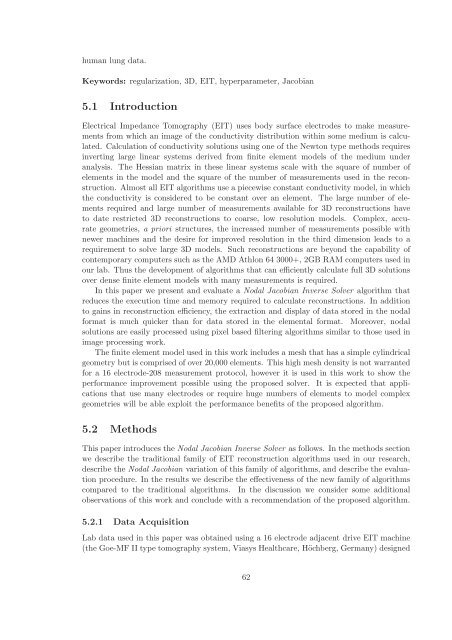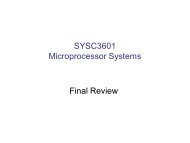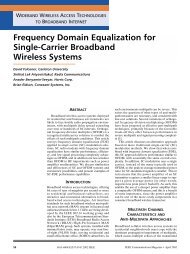Image Reconstruction for 3D Lung Imaging - Department of Systems ...
Image Reconstruction for 3D Lung Imaging - Department of Systems ...
Image Reconstruction for 3D Lung Imaging - Department of Systems ...
You also want an ePaper? Increase the reach of your titles
YUMPU automatically turns print PDFs into web optimized ePapers that Google loves.
human lung data.<br />
Keywords: regularization, <strong>3D</strong>, EIT, hyperparameter, Jacobian<br />
5.1 Introduction<br />
Electrical Impedance Tomography (EIT) uses body surface electrodes to make measurements<br />
from which an image <strong>of</strong> the conductivity distribution within some medium is calculated.<br />
Calculation <strong>of</strong> conductivity solutions using one <strong>of</strong> the Newton type methods requires<br />
inverting large linear systems derived from finite element models <strong>of</strong> the medium under<br />
analysis. The Hessian matrix in these linear systems scale with the square <strong>of</strong> number <strong>of</strong><br />
elements in the model and the square <strong>of</strong> the number <strong>of</strong> measurements used in the reconstruction.<br />
Almost all EIT algorithms use a piecewise constant conductivity model, in which<br />
the conductivity is considered to be constant over an element. The large number <strong>of</strong> elements<br />
required and large number <strong>of</strong> measurements available <strong>for</strong> <strong>3D</strong> reconstructions have<br />
to date restricted <strong>3D</strong> reconstructions to coarse, low resolution models. Complex, accurate<br />
geometries, a priori structures, the increased number <strong>of</strong> measurements possible with<br />
newer machines and the desire <strong>for</strong> improved resolution in the third dimension leads to a<br />
requirement to solve large <strong>3D</strong> models. Such reconstructions are beyond the capability <strong>of</strong><br />
contemporary computers such as the AMD Athlon 64 3000+, 2GB RAM computers used in<br />
our lab. Thus the development <strong>of</strong> algorithms that can efficiently calculate full <strong>3D</strong> solutions<br />
over dense finite element models with many measurements is required.<br />
In this paper we present and evaluate a Nodal Jacobian Inverse Solver algorithm that<br />
reduces the execution time and memory required to calculate reconstructions. In addition<br />
to gains in reconstruction efficiency, the extraction and display <strong>of</strong> data stored in the nodal<br />
<strong>for</strong>mat is much quicker than <strong>for</strong> data stored in the elemental <strong>for</strong>mat. Moreover, nodal<br />
solutions are easily processed using pixel based filtering algorithms similar to those used in<br />
image processing work.<br />
The finite element model used in this work includes a mesh that has a simple cylindrical<br />
geometry but is comprised <strong>of</strong> over 20,000 elements. This high mesh density is not warranted<br />
<strong>for</strong> a 16 electrode-208 measurement protocol, however it is used in this work to show the<br />
per<strong>for</strong>mance improvement possible using the proposed solver. It is expected that applications<br />
that use many electrodes or require huge numbers <strong>of</strong> elements to model complex<br />
geometries will be able exploit the per<strong>for</strong>mance benefits <strong>of</strong> the proposed algorithm.<br />
5.2 Methods<br />
This paper introduces the Nodal Jacobian Inverse Solver as follows. In the methods section<br />
we describe the traditional family <strong>of</strong> EIT reconstruction algorithms used in our research,<br />
describe the Nodal Jacobian variation <strong>of</strong> this family <strong>of</strong> algorithms, and describe the evaluation<br />
procedure. In the results we describe the effectiveness <strong>of</strong> the new family <strong>of</strong> algorithms<br />
compared to the traditional algorithms. In the discussion we consider some additional<br />
observations <strong>of</strong> this work and conclude with a recommendation <strong>of</strong> the proposed algorithm.<br />
5.2.1 Data Acquisition<br />
Lab data used in this paper was obtained using a 16 electrode adjacent drive EIT machine<br />
(the Goe-MF II type tomography system, Viasys Healthcare, Höchberg, Germany) designed<br />
62





